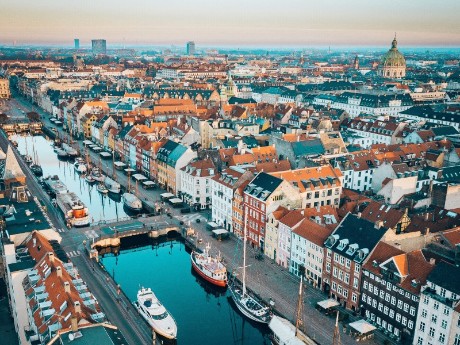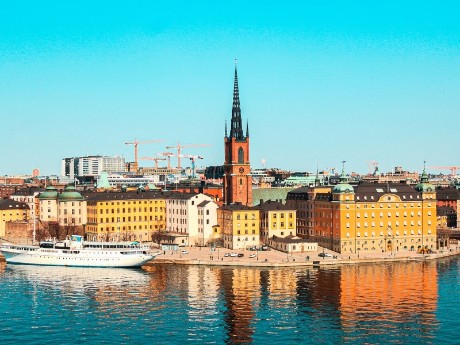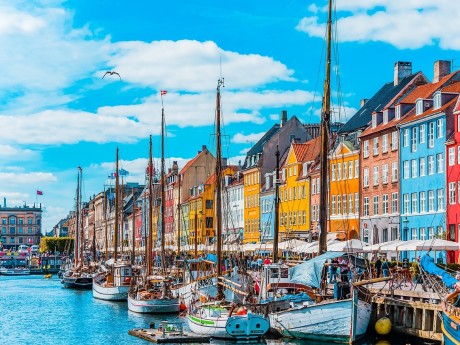Denmark & Sweden Capitals: Copenhagen & Stockholm
Legendary Amalienborg palaces, grand Round Tower, historic Vasa Museum, and fun Tivoli Gardens theme park. Beginning in Denmark's capital, Copenhagen, explore Amalienborg, a complex series of four palaces where the Danish royal family resides during the winter and fall. Visit the iconic Round Tower, an observatory tower built in the 17th century housing exhibitions, concerts, and other activities.
Read more
Legendary Amalienborg palaces, grand Round Tower, historic Vasa Museum, and fun Tivoli Gardens theme park. Beginning in Denmark's capital, Copenhagen, explore Amalienborg, a complex series of four palaces where the Danish royal family resides during the winter and fall. Visit the iconic Round Tower, an observatory tower built in the 17th century housing exhibitions, concerts, and other activities. Finally, don't miss out on Tivoli Gardens 19th-century amusement park with antique (wooden) roller coasters & live entertainment program. The trip continues to Stockholm, Sweden's capital. Begin with Vasa Museum which is one of the most visited museums in Scandinavia, and it holds the world's only preserved ship (a 64-gun warship) from the 17th century. The Royal Palace is also a must see as it is one of Europe's largest and oldest castles that still serves as an official royal residence (for King Carl XVI Gustaf). Don't forget to check out Skansenthe, the oldest open-air museum and zoo in Sweden showcasing the whole of Sweden with houses and farmsteads from every part of the country. Waterviews strives to offer accommodation options within walking distance of water and/or in an area of touristic interest. Our prices include taxes (but excludes local tourist taxes). Customize your trip to your personal preferences with optional activities (hit the “Add Activities’’) or change hotels, etc. Contact us for customization at no extra cost at: Service@waterviewstravel.com
Destinations
- Copenhagen
- Stockholm
Itinerary
Copenhagen

Copenhagen is the capital city of Denmark and forms the moderate conurbation that one million Danes call home. It is big enough to form a small Danish metropolis, with shopping, culture and nightlife par excellence, yet small enough still to feel intimate and be safe. Although mixed in its urban scene, the city is easy to navigate. Copenhagen is where old fairy tales blend with flashy modern architecture and world-class design; where warm jazz mixes with crisp electronica from Copenhagen's basements.
Read more
Copenhagen is the capital city of Denmark and forms the moderate conurbation that one million Danes call home. It is big enough to form a small Danish metropolis, with shopping, culture and nightlife par excellence, yet small enough still to feel intimate and be safe. Although mixed in its urban scene, the city is easy to navigate. Copenhagen is where old fairy tales blend with flashy modern architecture and world-class design; where warm jazz mixes with crisp electronica from Copenhagen's basements.
Additional Information
History
Beginnings as a merchant harbour
If you had dropped by Copenhagen in the 11th century CE/AD, you would have found yourself looking over a small fishing hamlet, with some lazy cattle gazing back at you while chewing fresh green grass from the meadows around the village. Looking east you would see a host of small islets protecting the small fishing harbour from harsh weather — not the worst place to found a city. If you would rather trust the written word than the archaeologists, the earliest accounts date from the 12th century, when a bearded clerk (or a renowned historian if you will) called Saxo Grammaticus scribbled down a few lines about the place; Portus Mercatorum, he called it, which was really just a fancy Latin version of Købmannahavn. This has since been mangled into København in modern Danish, and even further mangled into Copenhagen in English, but all it really means is "merchant harbour."
Archbishop Absalon
Around 1160 CE, King Valdemar handed over control of the city to the bishop of Roskilde. Absalon, archbishop of Lund 1177-91, one of the most colourful characters of the Middle Ages — a curious mix of great churchman, statesman, and warrior. As the country's only city not under the king's control, Absalon saw it thrive and erected a castle on what is today Slotsholmen (the remains are still visible in the catacombs under the present day parliament). As a man of religion Absalon also built a great church, and with those necessities taken care of, Copenhagen quickly gained importance as a natural stop between the two most important Danish cities, the old royal capital Roskilde and Lund in present-day Sweden. Endowed with an enviable location on the banks of the important Øresund Strait, it slowly but steadily surpassed the old urban centers. Copenhagen's rise was greatly aided by entrepreneurial trading with friends and foes alike and by prosperous fishing which provided much of Roman Catholic Europe with salted herring for Lent. But with prosperity comes envy and in the years to follow Copenhagen was laid waste and pillaged time and time again, mainly by the members of the German Hanseatic League, which at one point completely destroyed the city.
Becoming the capital of Denmark
Like the phoenix, however, Copenhagen repeatedly rose from its ashes. When the Danes kicked out the Pope during the 16th century Protestant Reformation, Roskilde lost its importance as a Roman bishopric and, having taken control of the city 20 years earlier, the Danish king moved his residence to Copenhagen. Not terribly keen on seeing their new capital laid waste once more, successive Danish monarchs built massive fortifications around the city. None more so than King Christian IV, who embarked on a building rampage which not only included the ramparts still visible throughout much of the city, but also many present day landmarks like the Round Tower and the Stock Exchange. Since then Copenhagen was besieged by the Swedes, and then bombarded, set ablaze, and nearly destroyed by the British Vice Admiral Lord Nelson, who in one of two battles for Copenhagen, responded to the order to withdraw by saying "You know, Foley, I have only one eye. I have a right to be blind sometimes," and then raised the telescope to his blind eye and touted "I really do not see the signal." This was the first ever civilian bombardment performed as part of war.
Outgrowing the city walls
Again, the city shook off its struggles and the population mushroomed during industrialization. When a cholera epidemic did a fine job of killing nearly everyone there wasn't room for, the King finally conceded that long range cannons would render its constraining walls irrelevant, and thus allowed the city to grow outside the now antiquated ramparts. But it was not long before a new modern fortification was built (known as Vestvolden today), which made Copenhagen Europe's most fortified city of the late 19th century.
After being subjected to yet another, German invasion during World War II, the whole idea of a fortified city was thrown out the window and replaced with one of the finest examples of urban planning anywhere — the Finger Plan. Copenhagen is one of few cities in the world to devise a long term plan for growth and then actually stick to it; try placing your hand over a map of Copenhagen with the palm as the city centre, and it's quite obvious why it's called the finger plan. Despite being the laughing stock of the country through the 1970s and 1980s, when wealthy residents all moved out into the fingers leaving behind an impoverished bankrupt inner city, a visit these days will prove that the Phoenix has risen once more.
Literature
Pelle the Conqueror (Martin Andersen Nexø, 1906–10). An epic novel in three parts and an integral part of the Danish school curriculum portraying the life of two poor Swedish immigrants — a father and son. The two last volumes take place in Copenhagen and describe the rise and the conflicts of the labour movement and global socialism which are so crucial to understanding Danish society today. All in all, it's a very good historical account of life in the city during that period, and above all, a good book. Smilla's Sense of Snow (Peter Høeg, 1992). Dive into Denmark's curious post-colonial history in this international best seller. Partly set in Copenhagen, partly in Greenland, you are whirled through a murder mystery by Ms. Smilla, a half-Danish Inuit brought up in poor Greenland, but now living in the kingdom's affluent and orderly capital. It is a good account of the conflicts and contrasts between two very different parts of the Kingdom, and it offers some spot-on social critique of Danish society in a very engaging way. The Copenhagen Quartet (Thomas E. Kennedy). Four novels totaling well over a thousand pages. Each book is set against the backdrop of one of the four seasons of the Danish capital: Kerrigan in Copenhagen (spring) (2013), Falling Sideways (autumn) (2011), In the Company of Angels (summer) (2010), and Beneath the Neon Egg (winter) (scheduled for publication, 2014). The novelist, an American expat, somewhat autobiographically portrays an American writer trying to come to terms with his past with the help of Copenhagen's many bars, with the Danish capital as the co-star. All of the places described in the books are real places that you can go discover.
Copenhagen is also the setting of several Nordic Noir films and series, such as the Pusher series, The Bridge, and The Killing.
Climate
Copenhagen, like the rest of Denmark, has four distinct seasons. The best time to visit is definitely the warm period from early May to late August. Current weather forecasts can be checked at the Danish Meteorological Institute website.
Spring, while a bit risky, as no one knows quite when it sets in, can be the best time to visit the city. On the first warm day, usually in early May, Copenhageners come out of hibernation and flock to the city streets, parks, and outdoor cafes in a veritable explosion of life, relieved that the country's dreary and dark winters are finally over. Many locals consider this the high-point of the year.
Summers in Copenhagen are usually warm with an average temperature of about 20°C, and the days are long — reaching the a peak of 18 hours on 21 June. If the weather becomes too hot, you can jump in one of the free pools in the cool harbour waters near the centre. Copenhagen's harbour is often considered the world's cleanest urban waterfront. Most of Copenhagen's annual events are held during June and July, and when the sun is out there is always life in the streets.
Autumn and winter have a profound effect on the city. The vibrant summer life withers and the streets go quiet, as most Copenhageners go directly home from work. This is where the Danish concept of hygge sets in, roughly translating into cosiness. It is the local way of dealing with the short dark days. Friends and families visit each other for home cooking and conversations by candlelight with quiet music on the stereo. In week 42 the Danes have an autumn holiday, with many events taking place, such as the night of culture. The height of winter is December, where Christmas brings some relief to the short days, with lights and decorations everywhere, in the streets, shops and in peoples' windows. Tivoli opens its doors for the Christmas markets, and most Danes go on a drinking rampage, with the very Danish and traditional Christmas lunches, with work and family.
Weather in Copenhagen can be unstable and highly unpredictable. Make sure you pack clothes in case of sudden rain or spell of cold (or, in the summer, of warmth) even despite long-term forecasts telling you otherwise. An umbrella, rain coat and shoes that will withstand torrential downpour may come in handy. Copenhageners dress very well, but at the same time very practically and with the realization that rain can assault their carefully chosen styling any minute.
Tourist information
Copenhagen's official tourist agency is Wonderful Copenhagen
© Sourced from Wikivoyage
Stockholm

As well as being the cultural, economic and political heart of Sweden, Stockholm enjoys a picturesque location stretching over fourteen islands where Lake Mälaren meets the Baltic Sea. Gamla Stan is filled with colourful buildings, cobblestone streets lined with trendy cafes and restaurants and historical buildings such as the Storkyrkan Cathedral. Stockholm has something for everyone, with Scandinavian design, world-class museums detailing everything from the Vikings to Abba, and a centre filled with green parks and scenic waterfronts.
Read more
As well as being the cultural, economic and political heart of Sweden, Stockholm enjoys a picturesque location stretching over fourteen islands where Lake Mälaren meets the Baltic Sea. Gamla Stan is filled with colourful buildings, cobblestone streets lined with trendy cafes and restaurants and historical buildings such as the Storkyrkan Cathedral. Stockholm has something for everyone, with Scandinavian design, world-class museums detailing everything from the Vikings to Abba, and a centre filled with green parks and scenic waterfronts.
Additional Information
Due to post-glacial rebound, much of today's Stockholm used to be under water. Mälaren was a bay of the Baltic Sea throughout the Viking Age of the 9th and 10th centuries; today's Stockholm was the waterway for the first Swedish cities; Birka, Uppsala, and Sigtuna. As Sigtuna was sacked by pirates in AD 1187, the Swedes needed to fortify the strait.
As the rising land cut off Mälaren from the sea in the 13th century, Stockholm became an important trading post. The city is said to be founded by Birger jarl (jarl is a title corresponding to British earl), who had a fortress built on an island later known as Gamla Stan. The first known written records that mention Stockholm date from 1252; this is the considered year of foundation. In the 15th century Stockholm replaced Uppsala as the effective capital. Stockholm was an associate of the Hanseatic League, and since its liberation from Denmark by King Gustavus Vasa in 1523, Stockholm has remained Sweden's most important center of commerce, although Gothenburg later became the largest international port. During the 17th century, Stockholm was the base of the Swedish Empire, with a land area twice the country's current size, nearly encircling the Baltic Sea.
Much of the inner city plan was laid out in the 19th century, and the inner city still contains buildings from all ages since the 15th century. Like the rest of Sweden, Stockholm was largely untouched by the World Wars, but, particularly between 1955 and 1975, hundreds of old buildings in Norrmalm were demolished in a large-scale modernization process, emulating similar projects in other European cities.
Since 1901, Stockholm has hosted the annual Nobel Prize ceremony for all categories except the peace prize, which is handed out in Oslo. In the 20th century, metropolitan Stockholm sprawled out across most of Stockholm County, with the development of the Stockholm Metro, famous for its contemporary art. 1950s suburbs such as Vällingby became a model for suburban development in other cities. While most of the attractions are in the inner city, a majority of the citizens live in the suburbs.
Otherwise a safe and calm city, Stockholm is also known for the term Stockholm Syndrome, which was coined to describe a hostage's sympathy for a captor during a bank robbery in Norrmalm in 1973.
Sustainable technology
As of the 21st century, Stockholm struggles to become a world leading city in sustainable engineering, including waste management, clean air and water, carbon-free public transportation, and energy efficiency. Lake water is safe for bathing, and in practice for drinking (though not recommended).
Some new neighborhoods with state-of-the-art technology in this field are Hammarby Sjöstad, Norra Djurgårdsstaden and Hagastaden.
Climate
Despite its northern location, Stockholm has fairly mild temperatures throughout the year. The city sees a dramatic seasonal variation in sunlight, from more than 18 hours of daylight around Midsummer, to around 6 hours of daylight around Christmas. Stockholm has an average of nearly 2,000 hours of sunshine a year. Average yearly precipitation is 539 mm (21.2"), with July and August slightly the wettest months. Snowfall can occur from late November to early April, but the amount of snowfall and snow on the ground varies greatly from year to year, and through the winter. No date is a safe bet for snow in Stockholm; for real Scandinavian winter, visit Dalarna or Norrland.
In other words, May to September tend to have the most comfortable weather. From Midsummer to the end of July, most inhabitants leave the city, and some venues close for summer, making the city more dominated by tourists.
Tourist information
© Sourced from Wikivoyage





